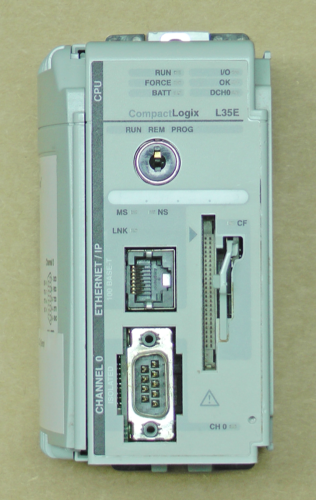
The second generation of CompactLogix controllers began with the release of the 1769-L35E back in 2003.
 It was the first CompactLogix to be released with Ethernet communications, and came out nearly two years before the first MicroLogix with Ethernet, the MicroLogix 1100.
It was the first CompactLogix to be released with Ethernet communications, and came out nearly two years before the first MicroLogix with Ethernet, the MicroLogix 1100.
But unlike the MicroLogix 1100, the CompactLogix L35E could also control distributed I/O devices like the Flex I/O and PowerFlex VFDs.
The L3x Family:
Each L3x controller in the CompactLogix’s second generation included a 9 Pin D-Sub “Channel 0” isolated RS-232 Serial Port, support for local 1769 Compact I/O in up to three banks, and a front facing memory card slot for CompactFlash cards predominately used as removable non-volatile memory.
And just like it’s predecessors, L3x controllers needed to be the “left most” device in the first bank of a 1769 system, located within four modules of a 1769 power supply.
All L3x controllers had a “Mode” Key Switch (same as SLC-500 and ControlLogix,) could be programmed through “Channel 0” via a Serial “Null Modem” Cable (1747-CP3 or 1756-CP3,) and had battery backed volatile memory (1769-BA.)
 To access the battery compartment, users simply slid the left side of the controller forward to reveal the battery connector and clip.
To access the battery compartment, users simply slid the left side of the controller forward to reveal the battery connector and clip.
These second gen CompactLogix controllers also had the same “default communications” button as the L20 and L30, which replaced the user’s “Channel 0” settings with the controller’s defaults.
Three Options:
The L3x line included controllers with three different memory and communication port options.

The smallest of the three was the 1769-L31 controller with 512K of memory, support for 16 local I/O modules and 4 concurrent tasks, and a physical 9 Pin D-Sub non-isolated RS-232 Serial Port.
The next size up was the 1769-L32x controllers with 768K of memory, support for 30 local I/O modules, and support for 6 concurrent tasks.
The L32x also came in two versions: The 1769-L32E had an RJ45 “Channel 1” Ethernet port, while the 1769-L32C had an RJ45 “Channel 1” NAP (Network Access Port) port that was tied internally to a single, bottom facing BNC ControlNet port.
The largest of the L3x family was the 1769-L35x controllers with 1536K of memory, support for 8 concurrent tasks, and a total local I/O capacity of 30 modules.
 Like the L32, the L35 came in two versions: The 1769-L35E had a RJ45 “Channel 1” Ethernet port, while the 1769-L35CR had a RJ45 “Channel 1” NAP port that was tied internally to redundant, bottom facing BNC ControlNet ports.
Like the L32, the L35 came in two versions: The 1769-L35E had a RJ45 “Channel 1” Ethernet port, while the 1769-L35CR had a RJ45 “Channel 1” NAP port that was tied internally to redundant, bottom facing BNC ControlNet ports.
The “Channel 1” port on both the L32 and L35 controllers could not only be used for programming and peer to peer communications, but also supported controlling distributed I/O.
In the end, this second generation of CompactLogix controllers proved to be extremely popular, and became the mainstay of the CompactLogix family for nearly a decade.
So, do you have L3 controllers installed in your facility? Or have you worked on them in the past? If so, what did you think of them?
You can share your thoughts and opinions with us by clicking on the comment link below my signature.
Until next time, Peace ✌️
If you enjoyed this content, please give it a Like, and consider Sharing a link to it as that is the best way for us to grow our audience, which in turn allows us to produce more content 🙂
Shawn M Tierney
Technology Enthusiast & Content Creator
Support our work and gain access to hundreds members only articles and videos by becoming a member at The Automation Blog or on YouTube. You’ll also find all of my affordable PLC, HMI, and SCADA courses at TheAutomationSchool.com.
- FactoryTalk Design Workbench First Look, CCW Comparison - December 19, 2025
- Drew Allen of Grace Technologies on Automation, Safety, and More (P256) - December 17, 2025
- Robotics in Warehouse Automation with Erik Nieves of Plus One Robotics (P255) - December 10, 2025

Discover more from The Automation Blog
Subscribe to get the latest posts sent to your email.



